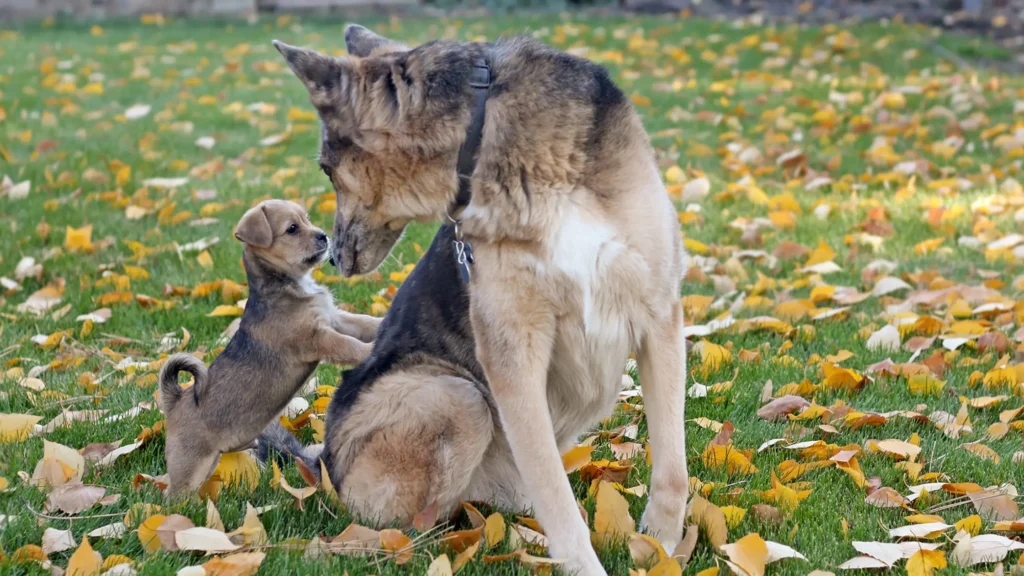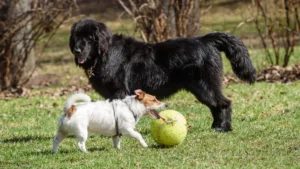Bringing a new puppy into a home with an existing dominant dog can be tricky. Proper planning and introductions are essential to avoid territorial behavior and ensure both dogs adjust comfortably to their new shared life. This comprehensive guide provides helpful tips and advice for how to introduce a puppy to a dominant dog.
Choosing the Right Puppy for a Dominant Dog
When adding a puppy to a household with a dominant adult dog, the first vital step is selecting an appropriate pup. There are a few key factors to consider:
Consider Size, Gender and Personality
Size matters. Picking a puppy that will grow to be similar in size to the adult dog helps prevent dangerous confrontations later. Tiny and large breeds typically don’t mix well. Opposites attract. Choose a puppy of the opposite sex to reduce same-sex aggression between mature dogs competing for your affection. Submissive is best. Ideally, select a puppy with a submissive personality who is less likely to challenge your dominant dog. Observe the puppy’s behavior with other dogs to determine their temperament.
Pick a Puppy of the Opposite Gender
Research shows that pairings of opposite-sex dogs often have less tension and fewer fights. This is likely because they don’t compete as intensely for territory or breeding rights. If your adult dog is female, bringing home a male puppy usually works well. And vice versa – a female puppy tends to mix easier with a resident male dog.
Select a Submissive Puppy
A submissive puppy who naturally shows appeasing postures is less apt to stir up trouble with your dominant adult dog. Signs of submission in a puppy include:
- Tail tucked
- Ears back
- Licking lips
- Rolling on back
- Avoiding eye contact
Puppies that demonstrate cautious behavior when interacting with unknown dogs are typically more compatible with domineering pets.
Preparing Your Home for a New Puppy
Proper preparations at home pave the way for a smooth adjustment period when adding a second dog. This involves setting up the needed supplies and creating safe spaces for both animals.
Buy Separate Supplies to Prevent Resource Guarding
Resource guarding is a frequent source of conflict between dogs. Your resident pup may become possessive and reactive about their belongings when a new puppy suddenly shares the same toys, bedding and dishes. Invest in duplicates of basic supplies like:
- Food and water bowls
- Beds
- Chew toys
- Balls/fetch toys
Place these items in different areas to provide clear boundaries. This also allows each dog to enjoy prized possessions without competition.
Puppy-Proof a Safe Space for the New Arrival
Puppy-proofing an enclosed room like the kitchen or laundry room prepares a secure spot for your new family member when you can’t directly supervise interactions with the adult dog. This separate space should have:
- Comfortable bedding
- Water and toys
- Pee pad if not yet housebroken
- Baby gate across doorway
Allow your resident dog to investigate the room first so it retains their scent and doesn’t become a foreign “threat.”
Involve Family to Assist with Introductions
Social support eases transitional stress for both pups and people. Ask trusted family or friends to lend a hand when you initially introduce the dogs. Having an extra person present to help manage and observe the dogs’ reactions is invaluable. It also means each dog gets personalized attention during meetings. If kids reside in the home, include them in caring for both animals as well. However, always monitor young children and dogs closely to prevent injury.
Meeting in a Neutral Location
The location of your dogs’ first encounter significantly impacts how greeting behaviors unfold. A neutral territory outside the home often works best to prevent fear-based aggression.
Avoid Territory-Based Aggression
Dogs, especially dominant ones, may react negatively when an unfamiliar “intruder” suddenly enters space they consider their own. Defensive aggression in response to a perceived territory threat is common. Invite the puppy onto the adult dog’s home turf after positive neutral territory introductions instead.
Use an Enclosed Outdoor Area
An enclosed yard, friend’s securely fenced backyard, or even an on-leash session at the park allows both dogs to interact while preventing bolting due to overstimulation. The ideal neutral location has sufficient room for the dogs to freely investigate each other, but is confined enough to easily intervene if needed. If the puppy isn’t fully vaccinated yet, steer clear of high-traffic public areas that may harbor contagious diseases.
Making a Proper Introduction
Orchestrating that pivotal first puppy–to–dog meeting requires awareness and finesse to ensure a positive experience. Take it slowly, create distraction-free focus between the pets, incentivize polite greetings, and allow brief, structured interaction.
Take It Slowly and Keep Dogs Leashed
At the pre-selected location, initially keep the puppy at a far enough distance that your adult dog notices but doesn’t react to their presence. Calmly move somewhat closer as both pets remain relaxed and distracted with toys or treats. Keep both dogs on loose leashes so you can quickly guide them away if needed. Take gradual steps closer until the puppy falls within polite greeting range, about four feet apart, while monitoring body language.
Provide Distraction and Rewards
Once the pup enters your dog’s four-foot bubble, offer a coveted chew bone or puzzle toy to shift focus away from the newcomer. As both dogs relax into enjoying their prizes, slowly decrease the gap between them while continuing to toss tasty morsels. Shower your adult dog with over-the-top praise and treats for ignoring the tempting distraction of the puppy. This reinforces composure.
Allow Brief, Positive Interaction
As the dogs appear comfortable enough to notice each other directly, allow brief sniffing. Encourage immediate disengagement by enticing both pets away from each other to claim wonderful treats on opposite sides of the yard before returning for another quick greeting. Keeping early interactions extremely short, even just nose-to-tail touches, prevents tension from escalating. End the session on a positive note once the dogs tolerate each other’s presence fairly near one another while staying relaxed.
Reading Your Dog’s Body Language
Carefully observing your adult dog’s body language, and the puppy’s as well, provides crucial insight into how to facilitate constructive introductions.
Relaxed vs. Aggressive Signals
Relaxed signals like loose muscles, upright tail, soft eyes, and play bows indicate your dog feels at ease enough to allow contact. Signs of impending aggression include stiffening, hair standing up, growling, baring teeth, hard staring, and deeply wrinkling the muzzle. Separate the dogs immediately if you notice aggression.
Let Them Interact If Relaxed
Allow the puppy and adult dog to sniff and initiate play when body language remains loose and happy. However, continually monitor even friendly interactions since a small puppy may accidentally trigger a sudden harsh reaction from your resident dog. If tension arises, interrupt the exchange with a cheerful voice while guiding the pets calmly apart. End interactions on a positive note whenever possible with praise and high-value treats.
Keeping Early Interactions Brief
In initial meetings during the critical introductory phase, limit contact between your puppy and adult dog to very short sessions of just five to ten minutes, even when going well.
Don’t Overwhelm the Dogs
Initially restricting exposure prevents both dogs from becoming overwhelmed. It also avoids triggering defensive aggression in your resident pup, who requires time to adjust to having to share their previously sole-dog domain. As the dogs become more comfortable with each other’s presence over days and weeks, gradually increase supervised playdates in neutral settings first before having them interact unsupervised at home.
Supervising the Dogs Together
Directly monitoring all interactions remains essential even months after adding a puppy to a household with other dogs. Dogs are wonderfully unpredictable creatures, so be prepared to handle surprises even between compatible canine companions.
Never Leave Unattended
When your adult dog and puppy seem to get along well, you might be tempted to leave them loose together while you run errands or are occupied elsewhere at home. Don’t give in to that temptation! Until you’re 100 percent confident they have a neutral or friendly relationship able to withstand inevitable disputes over toys or petting rights, never leave dominant dogs and puppies unsupervised together.
Intervene If Needed
While supervising dog-puppy play, make sure your dominant adult dog does not prevent the pup from resting or escaping interactions when tired. Also watch for intense staring, stalking or possessive behaviors around food bowls or resting spots that signal resource guarding issues that could lead to puppy injury. Calmly interrupt concerning behaviors using verbal cues or distraction techniques, and consider consulting a professional behavior specialist for additional support if problems persist.
The Key to Success: Patience and Positivity
Introducing a new puppy into a home with a resident dominant dog demands time, proper planning and copious patience. But with smart preparation and structured positive interactions in neutral settings, the dogs can gradually adjust to cohabitating contentedly. Remain calmly optimistic throughout the transition process. Be ready to troubleshoot bumps with temporary separation if needed, but otherwise take gradual steps letting the bonded relationship unfold over weeks or months at the dogs’ own pace. With consistency, prevention of competition for resources like food and toys and lots of praise for polite dog-dog behaviors, you’ll soon have two happy four-legged family members who thrive sharing your loving home.
FAQs about How To Introduce A Puppy To A Dominant Dog
How long does it take for a puppy to adjust to a dominant dog?
The time it takes for a puppy to adjust to a dominant dog can vary depending on their individual personalities and experiences. With patience and consistent training, most puppies can adapt to their new environment within a few weeks to a few months.
Should I intervene if my puppy and dominant dog get into a fight?
Yes, it’s essential to intervene immediately if your puppy and dominant dog get into a fight to prevent injuries and further escalation. Use distraction techniques to separate them and seek professional guidance if conflicts persist.
Can a dominant dog accept a new puppy into the household?
Yes, with proper introduction and management, many dominant dogs can accept a new puppy into the household. However, it’s essential to proceed cautiously and monitor their interactions closely to ensure a smooth transition.
How can I prevent conflicts between my puppy and dominant dog?
To prevent conflicts between your puppy and dominant dog, establish clear rules and boundaries, provide plenty of positive reinforcement, and supervise their interactions closely. Address any signs of tension or aggression promptly and seek professional help if needed.
Is it possible for a dominant dog to become submissive to a new puppy?
In some cases, a dominant dog may become more submissive to a new puppy, especially if the puppy displays confident and assertive behavior. However, this transition may take time and patience, and it’s essential to monitor their interactions carefully to ensure a positive outcome.
Useful Equipment
- Fresh Breathies to finally kiss bad doggie breath goodbye.
- Brush for dog hair.
- Dog Grooming Kit
- Pet Hair Lifter
- The Best High Quality Dog Food
- Pet Merchandise.
Useful Courses
- Brain Training for Dogs – the best & most effective dog training course in the market right now.
So, let us know did you find this article helpful? Are there any other questions you would like us to answer?
Let us know in the comment section down below.
If you are a dog or pet lover in general here are a few more articles you may find interesting:
- HOW TO GET YOUR DOG OR PUPPY TO STOP BARKING
- HOW TO TEACH YOUR DOG TO ROLL OVER
- WHY DO DOGS BREATHE FAST
- HOW TO LEASH TRAIN YOUR DOG
- HOW TO TEACH YOUR DOG TO SHAKE



